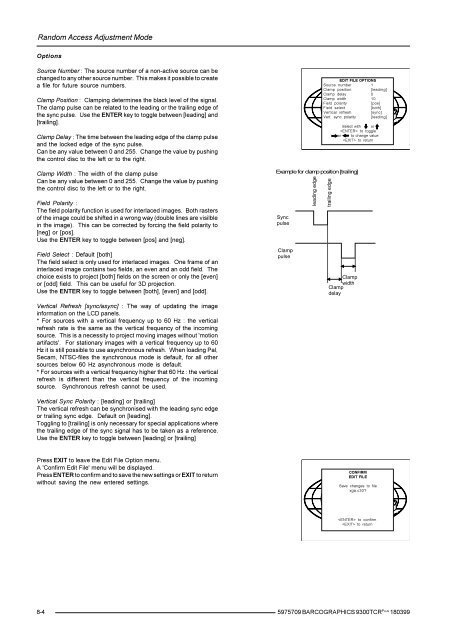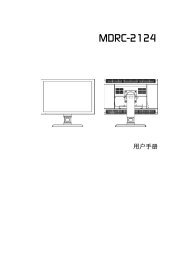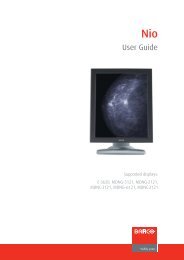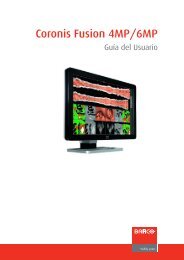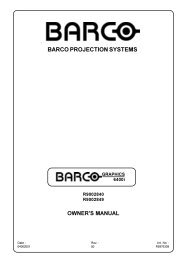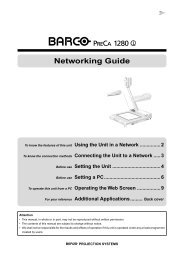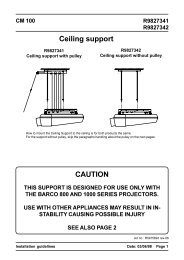BARCO PROJECTION SYSTEMS
BARCO PROJECTION SYSTEMS
BARCO PROJECTION SYSTEMS
You also want an ePaper? Increase the reach of your titles
YUMPU automatically turns print PDFs into web optimized ePapers that Google loves.
Random Access Adjustment Mode<br />
Options<br />
Source Number : The source number of a non-active source can be<br />
changed to any other source number. This makes it possible to create<br />
a file for future source numbers.<br />
Clamp Position : Clamping determines the black level of the signal.<br />
The clamp pulse can be related to the leading or the trailing edge of<br />
the sync pulse. Use the ENTER key to toggle between [leading] and<br />
[trailing].<br />
Clamp Delay : The time between the leading edge of the clamp pulse<br />
and the locked edge of the sync pulse.<br />
Can be any value between 0 and 255. Change the value by pushing<br />
the control disc to the left or to the right.<br />
Clamp Width : The width of the clamp pulse<br />
Can be any value between 0 and 255. Change the value by pushing<br />
the control disc to the left or to the right.<br />
Field Polarity :<br />
The field polarity function is used for interlaced images. Both rasters<br />
of the image could be shifted in a wrong way (double lines are visilble<br />
in the image). This can be corrected by forcing the field polarity to<br />
[neg] or [pos].<br />
Use the ENTER key to toggle between [pos] and [neg].<br />
Field Select : Default [both]<br />
The field select is only used for interlaced images. One frame of an<br />
interlaced image contains two fields, an even and an odd field. The<br />
choice exists to project [both] fields on the screen or only the [even]<br />
or [odd] field. This can be useful for 3D projection.<br />
Use the ENTER key to toggle between [both], [even] and [odd].<br />
Sync<br />
pulse<br />
Clamp<br />
pulse<br />
leading edge<br />
EDIT FILE OPTIONS<br />
Source number 1<br />
Clamp position<br />
[leading]<br />
Clamp delay 0<br />
Clamp width 10<br />
Field polarity<br />
[pos]<br />
Field select<br />
[both]<br />
Vertical refresh<br />
[sync]<br />
Vert. sync polarity [leading]<br />
trailing edge<br />
Select with or<br />
to toggle<br />
or to change value<br />
to return<br />
Example for clamp position [trailing]<br />
Clamp<br />
width<br />
Clamp<br />
delay<br />
Vertical Refresh [sync/async] : The way of updating the image<br />
information on the LCD panels.<br />
* For sources with a vertical frequency up to 60 Hz : the vertical<br />
refresh rate is the same as the vertical frequency of the incoming<br />
source. This is a necessity to project moving images without 'motion<br />
artifacts'. For stationary images with a vertical frequency up to 60<br />
Hz it is still possible to use asynchronous refresh. When loading Pal,<br />
Secam, NTSC-files the synchronous mode is default, for all other<br />
sources below 60 Hz asynchronous mode is default.<br />
* For sources with a vertical frequency higher that 60 Hz : the vertical<br />
refresh is different than the vertical frequency of the incoming<br />
source. Synchronous refresh cannot be used.<br />
Vertical Sync Polarity : [leading] or [trailing]<br />
The vertical refresh can be synchronised with the leading sync edge<br />
or trailing sync edge. Default on [leading].<br />
Toggling to [trailing] is only necessary for special applications where<br />
the trailing edge of the sync signal has to be taken as a reference.<br />
Use the ENTER key to toggle between [leading] or [trailing]<br />
Press EXIT to leave the Edit File Option menu.<br />
A 'Confirm Edit File' menu will be displayed.<br />
Press ENTER to confirm and to save the new settings or EXIT to return<br />
without saving the new entered settings.<br />
CONFIRM<br />
EDIT FILE<br />
Save changes to file<br />
xga.c30?<br />
to confirm<br />
to return<br />
8-4<br />
5975709 <strong>BARCO</strong>GRAPHICS 9300TCR PLUS 180399


